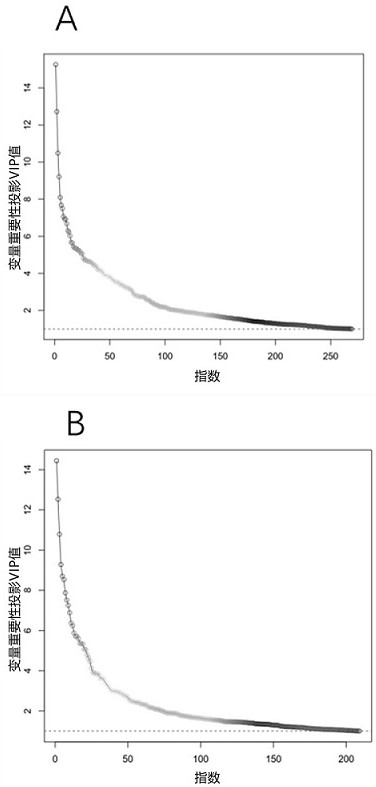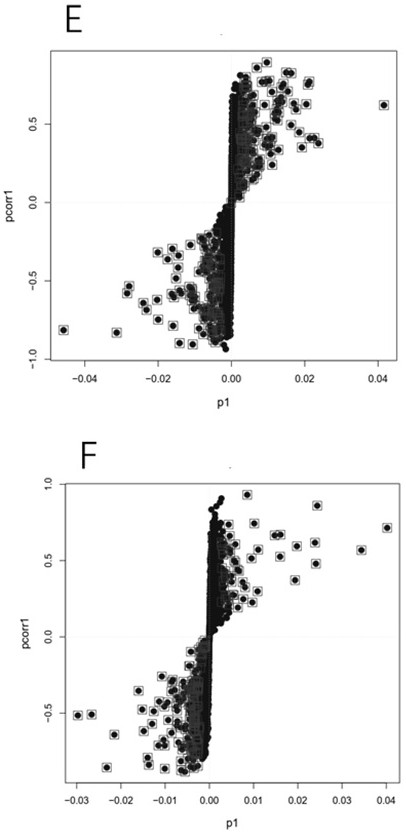Biomarkers and their applications for diagnosing the onset of nervonic acid in maple seed oil
A biomarker and nervonic acid technology, applied in biological testing, instruments, measuring devices, etc., can solve problems that are unclear and rarely studied
- Summary
- Abstract
- Description
- Claims
- Application Information
AI Technical Summary
Problems solved by technology
Method used
Image
Examples
Embodiment 1
[0029] 1. Sample collection
[0030] Thirty 5-6 week-old male SD rats were randomly divided into two groups, namely Yuanbao maple seed oil group (NA group) and normal control group (CK group). The rats in each group entered the experiment after adaptive feeding for 1 week. In the Yuanbao Maple Seed Oil group, the dose was calculated according to the drug dose conversion method between humans and rats, and the nervous acid contained in it was 0.03 g / kg / d orally administered once a day, and blood was collected after continuous administration for 1 day. The normal control group was fed routinely, and the sampling method was the same as above.
[0031] 2. Experimental instruments and reagents:
[0032] laboratory apparatus:
[0033] 1. Refrigerated centrifuge: Model D3024R, Scilogex, USA;
[0034] 2. Vortex oscillator: Model MX-S, Scilogex, USA;
[0035] 3. High-resolution mass spectrometer: ESI-QTOF / MS; model: Xevo G2-S Q-TOF; manufacturer: Waters, Manchester, UK;
[0036] 4...
Embodiment 2
[0056] In this embodiment, on the basis of embodiment 1, the blood collected after 3 days of continuous administration is analyzed for test results, and the experimental operation and method are the same as in embodiment 1. The result is as follows:
[0057] 1. Use multivariate statistics to find serum differences
[0058] Orthogonal Partial Least Squares Discriminant Analysis (OPLS-DA) combines Orthogonal Signal Correction (OSC) and Partial Least Squares Regression Analysis (PLS-DA) methods to screen for differential variables by removing irrelevant differences. The result is as Figure 4 , where A is the metabolite with VIP>1 in positive ion mode, B is the metabolite with VIP>1 in negative ion mode, and the VIP value is the variable of the first principal component of Orthogonal Partial Least Squares Discriminant Analysis (OPLS-DA) Importance projection, usually with VIP>1 as a common criterion for metabolomics, as one of the criteria for screening differential metabolites...
Embodiment 3
[0065] In this embodiment, on the basis of embodiment 1, the blood collected after 7 days of continuous administration is analyzed for test results, and the experimental operation and method are the same as in embodiment 1. The result is as follows:
[0066] 1. Use multivariate statistics to find serum differences
[0067] Orthogonal Partial Least Squares Discriminant Analysis (OPLS-DA) combines Orthogonal Signal Correction (OSC) and PLS-DA methods to screen for differential variables by removing irrelevant differences. The result is as Figure 7 is the metabolite with VIP>1 in the positive and negative ion mode, where A is the positive ion mode, B is the negative ion sample, and the VIP value is the variable importance projection of the first principal component of Orthogonal Partial Least Squares Discriminant Analysis (OPLS-DA) , usually taking VIP>1 as a common criterion for metabolomics, as one of the criteria for screening differential metabolites; Figure 8 The score ...
PUM
 Login to View More
Login to View More Abstract
Description
Claims
Application Information
 Login to View More
Login to View More - Generate Ideas
- Intellectual Property
- Life Sciences
- Materials
- Tech Scout
- Unparalleled Data Quality
- Higher Quality Content
- 60% Fewer Hallucinations
Browse by: Latest US Patents, China's latest patents, Technical Efficacy Thesaurus, Application Domain, Technology Topic, Popular Technical Reports.
© 2025 PatSnap. All rights reserved.Legal|Privacy policy|Modern Slavery Act Transparency Statement|Sitemap|About US| Contact US: help@patsnap.com



